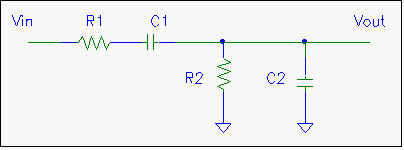In our daily lives a filter is a sorting process that allows us to separate people or behaviors we're interested in from those we aren't. Electrically the RC circuits we've looked at over the last couple of weeks show this sort of behavior. Depending on whether we were looking at the voltage across the capacitor in the circuit or the resistor we got different behavior at high and low frequencies. Think about which one might be described as a "high pass filter" and which as a "low pass filter".
This week we will look at a slightly more complex circuit and it's frequency dependent characteristics. Start with R1=R2 and C1=C2 where R*C = 10^-4 roughly. You pick the values. Later on if we have time we will consider what happens for more creative choices of R and C.

Purpose:
Now that we have some idea how to make measurements of the frequency dependent behavior of a circuit let's apply them to a slightly more complex circuit which is supposed to be a "band pass" filter. Let us hope that by the time you have collected some data you will have a sense for what this might mean.
Procedure:
1) Assuming that you have this circuit wired on a project board you should be ready to go. You have the tools and the skills to explore the performance of this circuit. Go forth and do so. Show me that you know how to test and explore a circuit to understand how it performs in the AC universe. I expect you will need all of the laboratory tools and skills you have developed thus far.
Lab "Notebook":
The following information should be clearly presented in your lab "notebook" along with explanatory and insightful commentary.
I) A clear drawing of the circuit constructed including the connections to any equipment
II) Present any measurements that you made and plots of said data.
III) Clearly describe the frequency dependent behavior of this circuit based on the data you have collected. How would you describe the transition behaviors that you observe and what happens to the amplitude of the signals?
